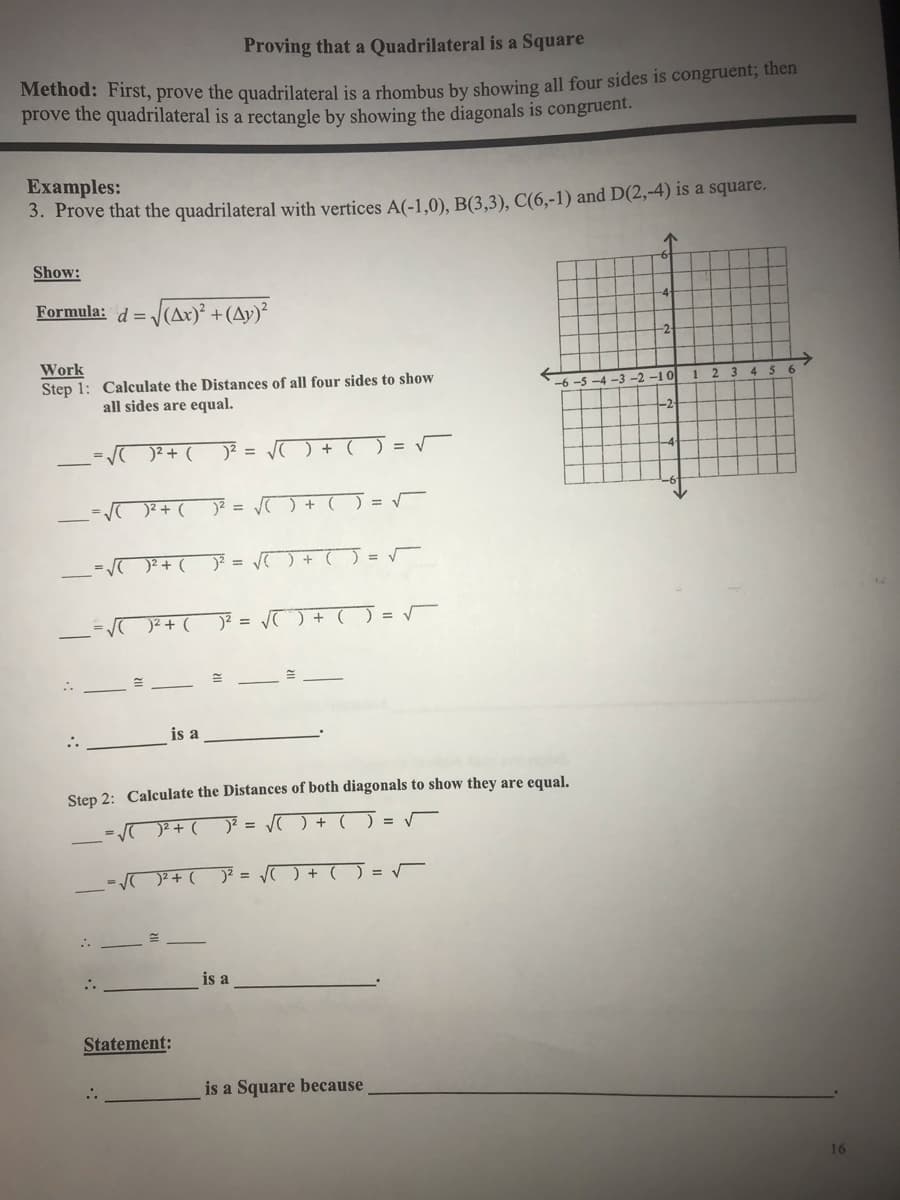nod: First, prove the quadrilateral is a rhombus by showing all four sides is cong e the quadrilateral is a rectangle by showing the diagonals is congruent. mples: "rove that the quadrilateral with vertices A(-1.0), B(3,3), C(6,-1) and D(2,-4) is a square. w: mula: d = J(Ax)* +(Ay)* %3D -2 ork pl: Calculate the Distances of all four sides to show all sides are equal. -6 -5 4 -3 -2 -10 1 2 3 4 5 6 -2 )² = JO +() = r %3D -4 VO? + ( )? = O+ ()= r -O + ( )² = J + ( ) = - %3D -O+ ( VO + O = r is a Step 2: Calculate the Distances of both diagonals to show they are equal. -O+ ( )² = /O + ( = - %3D -O + ( ² = O + ( ) = - %3D
nod: First, prove the quadrilateral is a rhombus by showing all four sides is cong e the quadrilateral is a rectangle by showing the diagonals is congruent. mples: "rove that the quadrilateral with vertices A(-1.0), B(3,3), C(6,-1) and D(2,-4) is a square. w: mula: d = J(Ax)* +(Ay)* %3D -2 ork pl: Calculate the Distances of all four sides to show all sides are equal. -6 -5 4 -3 -2 -10 1 2 3 4 5 6 -2 )² = JO +() = r %3D -4 VO? + ( )? = O+ ()= r -O + ( )² = J + ( ) = - %3D -O+ ( VO + O = r is a Step 2: Calculate the Distances of both diagonals to show they are equal. -O+ ( )² = /O + ( = - %3D -O + ( ² = O + ( ) = - %3D
Elementary Geometry For College Students, 7e
7th Edition
ISBN:9781337614085
Author:Alexander, Daniel C.; Koeberlein, Geralyn M.
Publisher:Alexander, Daniel C.; Koeberlein, Geralyn M.
Chapter10: Analytic Geometry
Section10.CR: Review Exercises
Problem 34CR: Prove the statements in Review Exercises 32 to 36 using analytic geometry. If the diagonals of a...
Related questions
Question
Fill in the blanks

Transcribed Image Text:Proving that a Quadrilateral is a Square
Method: First, prove the quadrilateral is a rhombus hy showwing all four sides is congruent, thên
prove the quadrilateral is a rectangle by showing the diagonals is congruent.
Examples:
3. Prove that the quadrilateral with vertices A(-1,0), B(3,3), C(6,-1) and D(2,-4) is a square.
Show:
Formula: d =
V(Ax)* +(Ay)²
-2
Work
Step 1: Calculate the Distances of all four sides to show
1 2 3 4 5
-6-5-4 -3 -2 -10
all sides are equal.
-2
= O²+ (
VO + (0 = r
= O?+ (
J= +() =
=O²+ (_ )? = JJ + (O = r
)² + (
)2 =
VO + () = r
is a
Step 2: Calculate the Distances of both diagonals to show they are equal.
= O² + ( )?
O + () = r
%3D
- O²+ ( )² = JO + (O = -
is a
Statement:
:-
is a Square because
16
Expert Solution
This question has been solved!
Explore an expertly crafted, step-by-step solution for a thorough understanding of key concepts.
This is a popular solution!
Trending now
This is a popular solution!
Step by step
Solved in 2 steps with 2 images

Recommended textbooks for you

Elementary Geometry For College Students, 7e
Geometry
ISBN:
9781337614085
Author:
Alexander, Daniel C.; Koeberlein, Geralyn M.
Publisher:
Cengage,

Holt Mcdougal Larson Pre-algebra: Student Edition…
Algebra
ISBN:
9780547587776
Author:
HOLT MCDOUGAL
Publisher:
HOLT MCDOUGAL

Algebra & Trigonometry with Analytic Geometry
Algebra
ISBN:
9781133382119
Author:
Swokowski
Publisher:
Cengage

Elementary Geometry For College Students, 7e
Geometry
ISBN:
9781337614085
Author:
Alexander, Daniel C.; Koeberlein, Geralyn M.
Publisher:
Cengage,

Holt Mcdougal Larson Pre-algebra: Student Edition…
Algebra
ISBN:
9780547587776
Author:
HOLT MCDOUGAL
Publisher:
HOLT MCDOUGAL

Algebra & Trigonometry with Analytic Geometry
Algebra
ISBN:
9781133382119
Author:
Swokowski
Publisher:
Cengage